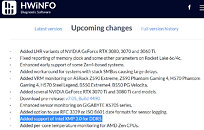Raevenlord
News Editor
- Joined
- Aug 12, 2016
- Messages
- 3,755 (1.18/day)
- Location
- Portugal
| System Name | The Ryzening |
|---|---|
| Processor | AMD Ryzen 9 5900X |
| Motherboard | MSI X570 MAG TOMAHAWK |
| Cooling | Lian Li Galahad 360mm AIO |
| Memory | 32 GB G.Skill Trident Z F4-3733 (4x 8 GB) |
| Video Card(s) | Gigabyte RTX 3070 Ti |
| Storage | Boot: Transcend MTE220S 2TB, Kintson A2000 1TB, Seagate Firewolf Pro 14 TB |
| Display(s) | Acer Nitro VG270UP (1440p 144 Hz IPS) |
| Case | Lian Li O11DX Dynamic White |
| Audio Device(s) | iFi Audio Zen DAC |
| Power Supply | Seasonic Focus+ 750 W |
| Mouse | Cooler Master Masterkeys Lite L |
| Keyboard | Cooler Master Masterkeys Lite L |
| Software | Windows 10 x64 |
The release notes for the latest version of famous system utility HWiNFO have spilled the beans on an update to Intel's XMP. Currently at version 2.0, XMP (eXtreme Memory Profile) is a technology that allows the system-level BIOS to run DDR memory at speeds higher than those allowed by JEDEC, the governing specifications body for all things memory. It extends the performance profiles usually made available via SPD (Serial Presence Detect). An update to Intel's XMP (XMP 3.0) for DDR5 memory is referred to in the release notes for version 7.05 of the software. Not much more to look at here - it remains to be seen what changes are actually a part of XMP 3.0, and if any increased utility will be added to these profiles. Remember, however, that nor Intel nor AMD (via its A-XMP implementation) enable warranty coverage should XMP be enabled in your system.
Other relevant updates for the application include advanced early support for Zen 4 systems (looking at you, AMD), as well as per-core temperature monitoring for Zen-based CPUs. There are other additions to the supported hardware, which you can find in the screenshot below.

View at TechPowerUp Main Site
Other relevant updates for the application include advanced early support for Zen 4 systems (looking at you, AMD), as well as per-core temperature monitoring for Zen-based CPUs. There are other additions to the supported hardware, which you can find in the screenshot below.

View at TechPowerUp Main Site



